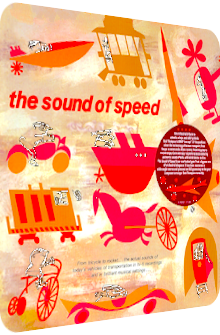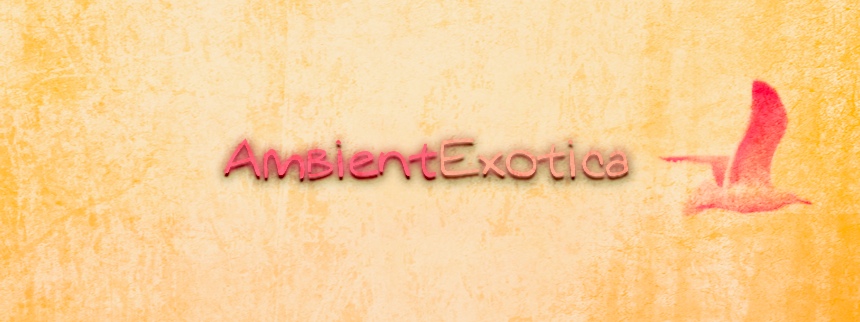
Bob Thompson
The Sound Of Speed
1959
The Sound Of Speed is a proper and no-compromise Space-Age artifact of 12 unique compositions, all of them envisioned, composed and arranged by orchestra leader Robert “Bob” Lamar Thompson (1924–2013) and released in 1959 on Dot Records, followed by an immediate reissue in 1960. A very successful work despite – or because of – its seemingly gimmicky use of field recordings, its biggest achievement is found in-between the superbly multilayered string cocoons, the throning as well as silkily veiled brass counterparts and the many harps, flutes, triangles, mallet instruments, timpani and other devices that occur throughout the colorful settings.
Although no bongo or conga ever appears on this record, Exotica fans will find many a distinct tonality and moment of enchantment to be impressed of. The album has three standout features: said amount of 12 unique tracks, followed by the fact that it is recorded on site in Rome by the Orchestra dei Concerti di Roma (conducted by Paul Baron), and finally the intertwinement of all fast and not-so-speedy vehicles via actual recordings of their attributes, be it mere tricycles, speed boats or even rockets. This is a technocratic record, hailing technology as a scintillating field of making everyone’s life simpler and tying society closer together. The blurb on the front cover promises much, and Thompson keeps this promise: “From tricycle to rocket. The actual sounds of today’s vehicles of transportation in hi-fi recordings. And in brilliant musical settings.” Be it pizzicato tohubohus, legato sinews of pure magic or incidents of cinematic proportions with the fitting instrumentation and pizzazz, The Sound Of Speed is always leading, racing the tide, being on top. I will carve out its many achievements and little obstacles over the course of this review.
Shocker! A moment of shock has rarely been so delightfully improved by a superb immediate elation. Right at the beginning of the opener Super Chief, Bob Thompson sends a diesel train through the listener’s cochleae, its strong signal being horrifically life-like and eruptive. What follows, though, is pure bliss: show tune-compatible brass blasts and string infusions à la Hollywood, gleaming and glaring in technicolor. There is no care in the world that can stop the train, and even though the amount of horns decreases and their presence wanes, they reoccur in silkened form time and again, now subordinate to the whooshing strings and the last encore of the train. Midnight Sailing meanwhile takes place on an ocean liner and almost cracks the four-minute mark. The composition resembles the opener but appears more majestic and solemn. After the enmeshment of the archetypical steamer signals, the listener is harbored in mauve-tinted strings and genteel piano movements. I could leave it at that, but blimey, Thompson is no one-trick pony, and so the second half of Midnight Sailing is mercilessly effervescent and bubbly, featuring flute formations, harp helixes and cymbal crests en masse. A marvelous gem!
The following La Vespa already carries excitement and tachycardia in its title, and as if that weren’t enough, Thompson unleashes said high-octane motor scooter and takes the opportunity to visit Italian climes, the homeland of the legendary vehicle. The strings are therefore less spacey and much more sun-kissed, the corset in 6/8 time holds mountainous staccato horns, moments of discordance and camouflaged craziness but is all in all still sunny enough, withstanding even these estranging sunbursts. Sub-Manhattan Blues then showcases the well-known clattering and clanging of the subway, and a Blues it is alright, wondrously histrionic and dun-colored, with piercing strings and laissez-faire trombone countermovements. Like a pipe dream, the composition oscillates between the pesky way to work and a moiré of surreality concerning this exertion. I bet that many a pen-pusher would still be more than happy to ride the subway if he or she was forced to use the tricycle to get there, a vehicle which is incidentally in the limelight next.
The Three-Wheeler Waltz imposes child-like wonder via coruscating cowbells, moist marimbas, galloping drums and slightly off-key trombones which form the base of the Waltz structure. The glissando of harps and sweeping tambourines as well as high-rise flutes then round off the gleeful setting which fittingly ends with a proud child on the tricycle. The final song of side A has luckily lost all of its portentous connotations. Count Down is about a missile. Considering the Cold War era, this was probably not the most soothing piece, but this kind of Space-Age Crime Jazz synergy works fantastically well. The bleeping countdown is in the center, girdled by pompously technocratic post-Roman brass fanfares, droning timpani and vitreous cymbals. And then the missile launches. Were this the final track of the album… oh my!
Luckily, there is side B to keep us company, washing away all those dark thoughts. It continues Thompson’s cinematic scope without any stylistic break or quirkiness. Star Fire literally lifts off where Count Down faded out. Featuring a jet plane amid fairy tale-interpolated pizzicato string concoctions, plinking triangles and a flurry of flutes, this is a gorgeous Space-Age anthem of insouciance to the third degree. Surrey Serenade then moves back into retrogressive climes by featuring a horse and a buggy. The composition is hence a tad tipsy, celebratory and quite a bit more leisurely and bucolic than the technophile surroundings might propose. And how cute, there is indeed a mare galloping through the arrangement. Nice touch! While Le Mans is unsurprisingly all about sport cars, their creaking brakes and whirring cavalcades of carefree strings and sunset-hued horns, Streetcar Named Irving is a cutesy ditty that shuttles between the tonality of side A’s Three-Wheeler Waltz and Surrey Serenade. More laid-back, awash with daylight and comparably slow, this is a piece of devotion and marker for the love of antediluvian means of transportation.
Sea-Spray then ventures into aquatic territories, presenting dark brass-underlined speed boats in a glassy-glossy array of pointillistic mallet instruments, flutes and triangles, with legato strings washing over the beautiful day out on the lake, all the while the closer Early-Bird Whirly-Bird invites the listener to a rotatory ride in a helicopter. Another Waltz at its core, the chintzy trombones and quavering strings turn out to be disappointing, as the tone sequences are too whimsical and cheesy, especially so in the ebullient context of the album. However, it is no complete misstep either, so no harm is done at the end of the ride.
Bob Thompson’s The Sound Of Speed is a wonderful Space-Age artifact. Only nitpickers and the cheeky reviewer would hold on for a moment and state that not each and every unique composition lives up to the concept of speed as advertized: Three-Wheeler Waltz, Surrey Serenade and Streetcar Named Irving are but three examples where the tunnel vision cannot unfold by the very nature of the vehicles alone, but okay okay, I am really just playing the role of the spoilsport instead of truly epitomizing it, as even these arrangements feature strings and horns en masse. The Sound Of Speed is at its best, however, when said instruments become either warped and twisted or strikingly cinematic in a good way, emanating euphony next to euphoria as well as elation next to elevation. The overall anatomy of the album is coated in ever-vivacious Space-Age strings, and it is all the sadder when these instruments are used to merely depict sunny days and blue skies instead of hallucinatory flashes of light or transcendental mirages.
One additional downside should not remain unmentioned, though it does not destroy the listening experience: the field recordings often feel admittedly gimmicky and are used in a very formulaic fashion. They set the tone and introduce the composition and more often than not kiss the listener goodbye at their very end. Sometimes, they appear in the middle or for a longer time, for example the horse in Surrey Serenade or the eerie countdown in, well, Count Down. The Sound Of Speed is available on vinyl and as a restored remastered 2003 reissue on Bacchus Archives. Do not take my occasional criticism to heart, Thompson’s vehicle galore offers a blast in its best moments and a good ride in its worst ones.
Exotica Review 369: Bob Thompson – The Sound Of Speed (1959). Originally published on Aug. 30, 2014 at AmbientExotica.com.
